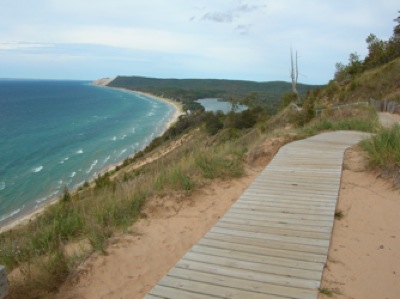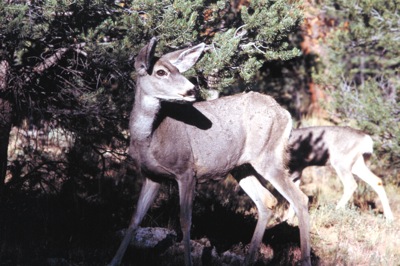
Volunteers, hard work keep parks clean
The roughly 300 million people who visit our national park system each year leave behind a lot of trash. Unfortunately, not all of it makes its way to the proper place.
Despite public awareness campaigns and the installation of receptacles throughout the parks, trash and litter control remains a priority.
Volunteers play a huge role in keeping our parks clean. Large numbers of people in vast locations, such as the Great Smoky Mountains National Park in East Tennessee and North Carolina, generate a lot of trash. The park, which comprises more than one-half million acres, receives an annual average of 10 million visitors. It is the most frequently visited national park in the country.
| Click on the video at right to view an audio slide show about keeping our national parks clean prepared by writer Mike LaSusa. |
According to Dana Soehn, volunteer coordinator for the park, volunteers spent 3,410 hours exclusively on litter patrol projects last year.
“We also spent another 4,518 hours cleaning up our backcountry trails and campsites and then another 3,352 hours on special patrols in the backcountry where we had to recover large amounts of litter left behind by unprepared hikers,” said Soehn. “Not only do the VIPs [volunteers in-park] help our park look better, but they also help us protect both the terrestrial and aquatic habitats, making them a cleaner, healthier environment.”
So how does the park convince people to come out and pick up other people’s trash?
“We are fortunate to have many willing volunteers that seek us out to find out how they can help take care of the park. We have several school groups, scout groups, alternative spring break groups, and college interns that spend time learning [about] and caring for the park,” said Soehn.
| Employees of Great Smoky Mountains National Park show off trash they collected on “Roads and Rivers Day” (Photos courtesy of the National Park Service). |
For smaller parks, such as Acadia National Park in Maine, which consists of about 47,000 acres and receives about two million visitors per year, volunteers are also vital.
Acadia’s Chief of Maintenance, Jim Vesaki, estimates the annual cost of trash removal in the park to be $120,000. The cost would be much higher without the many volunteers who give their time.
“We have a full-time volunteer coordinator who spends a portion of his time working with groups doing trash pickup,” said Vesaki. “Our Friends group also organizes volunteer roadside cleanup actions on roads leading to the park. We have many hundreds, if not thousands, of volunteer hours per year [committed to] roadside and coastal trash cleanup.”
Some parks are fortunate enough to have few problems with litter, such as the Sleeping Bear Dunes National Lakeshore in Michigan, which receives about one million visitors each year to its 71,000-acre park.
| Some of the volunteers who help keep Great Smoky Mountains clean. |
“Our public is generally very respectful of the lakeshore and its pristine nature and, in general, they don’t create an overwhelming litter problem. We have a very limited number of staff responsible for collecting solid waste throughout the lakeshore and we have a very strong volunteer program where we get several thousands of volunteer hours per year,” said Facility Manager Lee Jameson.
The Grand Canyon, one of the country’s largest parks with more than 1,217,000 acres and four million annual visitors, relies less on volunteers than many others.
Last year, volunteers put in just 483 hours of litter pick-up. Nonetheless, the park spends approximately $820,000 on maintenance personnel, contracted haul-off and dump charges, and its recycling program each year.
A large portion of our parks’ garbage comes from places like campsites, museums, visitor centers, restaurants and concessions and ends up in bins, dumpsters and other containers.
 |
Respectful visitors and dedicated volunteers help to maintain the pristine nature of the Sleepin Bear Dunes. |
Most parks, such as Grand Teton National Park in Wyoming, which does not use volunteers for trash-removal, hire full-time staff to collect trash from around the park and bring it to a few central collection locations. From there, the parks usually employ third-party companies to deliver the trash to landfills and recycling centers.
The parks are very conscious of their environmental impact and often have substantial recycling programs in place. For example, the Sleeping Bear Dunes recycles 88 percent of the 69 tons of trash it collects on an annual basis.
According to Jameson, the park is currently implementing a more site-specific recycling effort, which will be accomplished largely with the help of their dedicated volunteers.
Jameson explained that the park also tries to improve their “sustainability” with other practices.
“We purchase a lot of paper products and 100 percent of those are recovered materials. We also recycle our oil [and] we use biodiesel,” he said.
Some parks have installed bear-proof trashcans along their trails to protect wildlife.
“Deer have starved to death because of their stomachs being full of trash and condors have been x-rayed with coins and other trash in their stomachs,” said Tim Jarell, the Grand Canyon’s chief of Maintenance.
| Deer are just one of the animals negatively affected by trash in the parks. |  |
Grand Teton is also implementing a program to encourage visitors to use refillable water bottles in order to reduce the use of plastic.
As Grand Teton Public Affairs Specialist Jackie Skaggs put it, “We’re always looking for ways to reduce garbage.”

Comments are Closed